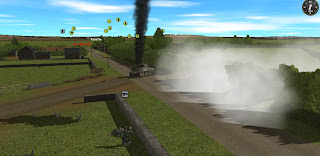It’s safe to say that you need to approach Combat Mission: Battle for Normandy a little differently than you are used to with most modern games. I, in my infinite wisdom, jumped straight in without even a glance at the manual. That was a big mistake. At first, I persisted in trying to learn as I go but after struggling through the tutorial scenarios, after taking way to much time to finish them, I gave up and started reading. I’m not one to shy away from a juicy manual and I kind of miss their presence in most modern games.
 |
| Where there’s smoke… |
The fact of the matter is, developers have gotten so much more efficient in relaying all relevant information to gamers, through tutorials, that manuals have become almost extinct. Combat Mission’s tutorial system feels like it was made in the nineties. The manual is essential and the tutorial scenarios are only exercises in frustration without it, especially if you have never played a wargame before.
|
The number of units you need to manage at times can be daunting
|
The two tutorial campaigns are essentially split into teaching you how to move around and give out various commands, and how to setup a battle, strategise and overwhelm the opposition. Both deliver their intended purpose adequately, but I feel like the developers could have done more to inform you in-game rather than making you read the manual for any relevant information. When it comes to helpful hints and tips the UI is a wasteland. There is plenty of information there, but the game requires you to learn its language to make any sense of it all.
To its credit, if your knowledge of real world military structure and tactics is good, then everything will make more sense. My own apprehension of such matters was rusty at best, so I began reading up on the basics. It helped a great deal as I began to grasp the intricate details of the game.
|
The user interface makes little sense before you read the manual, but is actually quite nice once you decipher it. I still would like to have some pop-up tool tips
|
CM:BN’s greatest strength, and perhaps its most discouraging hurdle, is the amount and quality of the systems included in the simulation. If you want to master the game you need to be able to understand the tactical doctrine that it’s based on. Everything needs to be taken into consideration when forming a strategy to take on a specific battle. The chain of command, the terrain, the weather, your troops morale, and everything else you could imagine would factor into a real battle.
There are two basic ways to play the game. Real time where you can pause at any time to give out orders, and turn based where you give out orders and when you start the turn a minute, real time, passes during which you can’t influence the battlefield. In multiplayer the turn-based system, called We Go, players issue orders simultaneously and then the turn plays out. I’ve been switching between the two modes and I can’t decide which one to choose. Both are very competent ways to play the game, and each offers unique challenges.
You can set up your own Quick Battles where you customise your force with a predetermined allowance. Choose the size of your battle field and select from a variety of different map styles. This feature insures a high level of replayability where you can play hundreds of battles without hitting the same scenario again. The AI insures you wont get bored doing this, assuming that you have a general interest in playing endless battles.
|
The ground type can make a big difference. A wet swamp will significantly slow down and tire your troops.
|
|
The units in the game are beautifully detailed which really enhances feeling of WWII.
|











